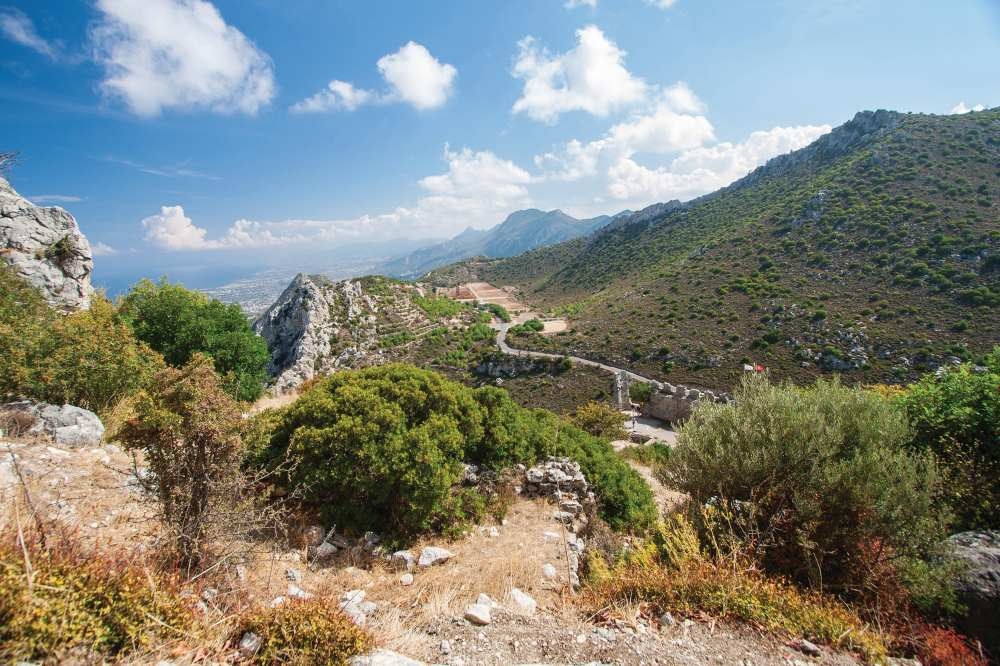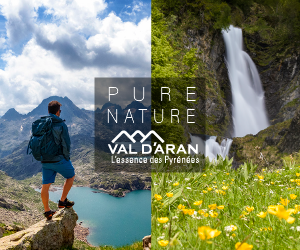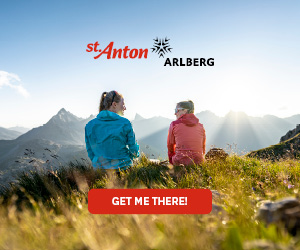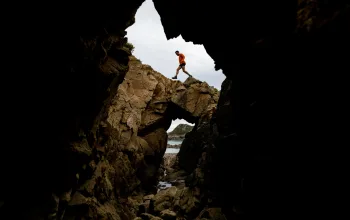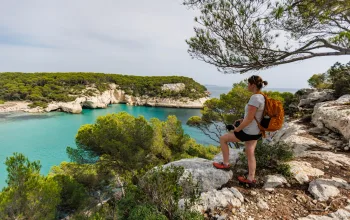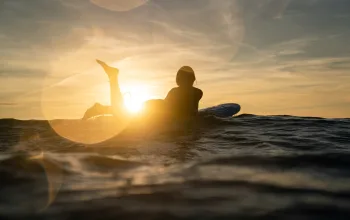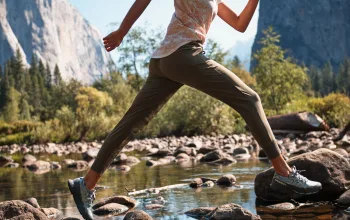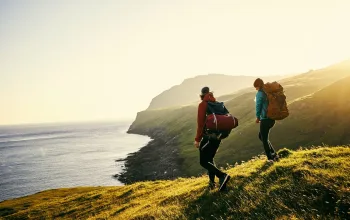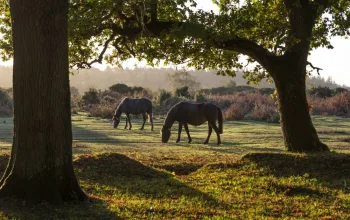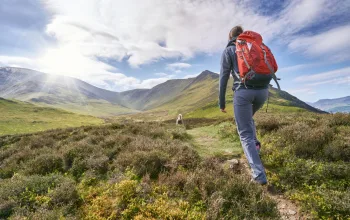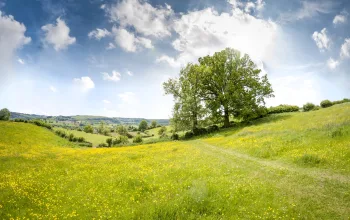On a fresh a late May morning, we follow the zigzag path ever-upwards towards the imposing Buffavento Castle straddling the spine of the Kyrenia Mountains high above us. The medieval structure seems to teeter precariously on a ridge – and yet has stood firm for almost a thousand years.
Now in the Turkish-occupied area of North Cyprus, the castle was built as a watchtower to ward off invaders in centuries past, and its name means ‘defier of the winds.’
Climbing in the lee of the mountain, our ascent has been relatively sheltered, and it’s only when we arrive at the rocky pinnacle 955 metres above sea level that we fully appreciate its exposure to the elements.
Built by the Byzantines in the 11th century, the castle was further expanded by the Lusignans in the 14th century, only falling into disrepair later after the Venetians abandoned it. The powerful Republic from the north built their own impressive castles on its most southern territory, and these still dominate Kyrenia and Famagusta.
Buffavento Castle makes a stunning viewing platform though, and once on top, my daughter Laura, 15, and I absorb the coastal panorama of Kyrenia below, with its compact, perfectly formed, old harbour.
In the opposite direction, through the haze, lies Lefkosa. Perhaps still better known outside the Middle East as Nicosia, it is the divided capital of Cyprus, with the Green Line – the 112-mile United Nations buffer zone between the two parts of the island – separating Greek and Turkish interests.
The island has been divided since the troubles of 1974, though from the ancient and peaceful vantage point of the castle it’s difficult to image the ground level divisions.
Monumental landscape
We’ve joined a group of hikers today who have been exploring North Cyprus, and this diversion to Buffavento is in fact an aperitif, an appetiser, to the main walk of the day.
The main course, continuing the theme of culture, history, forest paths and impressive landscape starts at a trailhead half an hour’s drive from Kyrenia.
As the morning freshness burns off and the day warms, we set off on a narrow but well-marked path, again on a steady upward incline, but this time grateful for the shelter of the trees, as the sun rises ever-higher.
At times the path is steep and rocky, at others softer under foot as we walk through the forest of pine, cypress and wild cherry.
Then suddenly, as we emerge from trees, the island’s famed five-finger rock – named for its digit-shaped peak – becomes visible. This is a monumental natural landmark, rises lonely from the landscape, its limestone and marble cliffs a talismanic symbol for hikers.
Throughout our walk the path we follow is well defined by green and white markers etched on rocks or painted on prominent trees. We’re walking part of the Alevkaya Kuzgun Trail to the east of Kyrenia, and it’s certainly no stroll in the park, with occasionally challenging steep sections – but the views along the 100-mile range and out to the sea make it worth it.
It is this wild, relatively untamed character of routes where you will probably not meet other hikers all day long, and a variety of terrain, that is the appeal of hiking in North Cyprus.
Especially in springtime, with its abundance of flowers, orchids, greenery and a freshness to the air not felt in summer.
Food for the eyes
With the mid-day sun overhead, we emerge into a clearing, and perch on a raised wooden platform for a picnic lunch of fruit and cheese rolls. The five-fingers of Pentadaktylos mountain form a magnificent backdrop, as our guide, Engin Sah, treats us to cakes, which he has carried all this way.
Fed and watered, we set off again on the increasingly steep and rocky path, the soft underfoot giving way to firm stone.
Soon the trail takes us above a deserted Armenian monastery, whose grey walls are covered in patches of moss, decaying stonework and empty windowless rooms.
The monks fled during the troubles of 1974, never to return. Today it stands as a curiosity to passing hikers, a centuries-old relic of Christianity in the northern part of the island – where you are more likely to hear the call of the muezzin from the mosque’s loudspeakers than the church bell.
The final stretch of the walk takes us over a series of steep ascents and descents before we emerge into the village of Alevkayasi, where we rejoin our minibus.
In fact, although many of North Cyprus’ signed walks are circular, transport is essential and in this case most welcome as it nips us down to the beach for a dip in the sea and ice cream before we return to the hotel.
Self-guided walking will be even easier from this year, now the government has published a series of trail maps for the island. There are some 580 kilometres to walk – all clearly marked with white and green signs – with differences in elevation, flora and fauna.
There are also routes for cycling, though this remains a developing area of North Cyprus’ activity-based options but for those bringing their own mountain bike with them, there is a good, sign-posted, trail network on quiet roads and marked paths.
The call of the sea
With warm, clear waters, and an equally inviting climate, North Cyprus is a popular destination for water-based activities and sports including scuba diving, kite surfing, water skiing, and fishing.
Laura has never dived before and it’s a while since I have, so it’s the perfect activity to break up our walks in the mountains. But first, as always in North Cyprus, there’s food.
Cuisine is an integral part of the culture here and a real gem for a meal is Erson Hoca’s Organic Farm where the menu is based on produce grown on the farm – with strawberries and apricot in abundance, you can even pick your own dessert.
We savour a meal of slow-cooked lamb and roasted potatoes, salads, humus, stuffed vine leaves and marrow plant flowers with artisan bread for under £10 (40TL), while you can stay the night for 45 euro per person bed and breakfast. The farm is run by Nursel Hoca, who has taken up her late husband’s dream of opening the organic farm to visitors.
The Mediterranean diet – with Turkish, Greek, Lebanese and Armenian influences – means rich, irresistible flavours are all part of the experience of small family-run restaurants. Meze-style lunches are a favourite during our stay, where we pick from dishes including molohiya (lamb and spinach), mixed vegetables of courgette, aubergine, tomatoes and peppers, as well as rice, chicken, humus, pasta and mince dishes.
Dive in!
For our diving we join Cenk, whose family has run Scuba Cyprus for 25 years, within the shelter of Camelot Beach; a refresher dive for myself and a ‘try dive’ for Laura as her first ever experience using an aqualung.
The backdrop is slightly incongruous; mountains, a beach resort, sheltered inlet, restaurant and an abandoned machine gun bunker. But this is North Cyprus.
Walking into the shallow waters, we descend to two and eventually 4-5 metres with Laura growing in confidence alongside the instructor while I hang back slightly as she enjoys her first dive.
It is one of those unique father-daughter moments, of doing something special together; the first red ski run, or the first football match, and diving together is definitely up there with the best of the rest.
The water could hardly be better too: with visibility up to 30 metres, lovely and warm and, at Camelot Beach, safe and calm conditions.
Laura, diving for the first time, is able to enjoy a 30-minute dive under close supervision and whet her appetite to move on to an Open Water course.
What particularly impresses is the standard of the equipment, the approach of Scuba Cyprus and the quality of the instruction giving beginner divers time and support to ensure they are confident in the water and with the equipment, also ensuring more experienced divers get the best out of their dives.
Later, we’re taken off shore for a dive down to about 28 metres where the visibility is superb, despite a strong undercurrent.
Laura stays in the boat with her instructor Sahu while Cenk and I drop into the choppier waters and follow a line down to the seabed.
Pots, possibly ancient, are strewn around, and while there are grupa, starfish, marine turtles and moray eels in this area, the highlight of the dive is a 40-pound amberjack.
Island explorers
On spare days and evenings, skin glowing from the magical combination of mountain sun and salty sea, we make the best of exploring this compact yet diverse island. Famagusta on the east coast is one such diversion. Built by the Venetians in the 15th century, it hosts an ancient citadel with stone fortifications. But the history of Cyprus stretches back far beyond, epitomised by the fascinating Roman ruins just up the coast at Salamis with its amphitheatre and baths.
We stayed near Kyrenia, or Girne in Turkish, a lively town on the north coast focussed around a small harbour jammed with fascinating wooden day boats. I would say it is one of the most beautiful harbours in the Mediterranean.
Although reaching North Cyprus is not straightforward, with flights from the UK routed through Turkey, it is worth it for the Active Traveller. You’ll be welcomed with genuine hospitality and find an authentic, distinct Aegean culture, as well as a beautiful climate and delicious cuisine.


